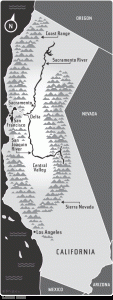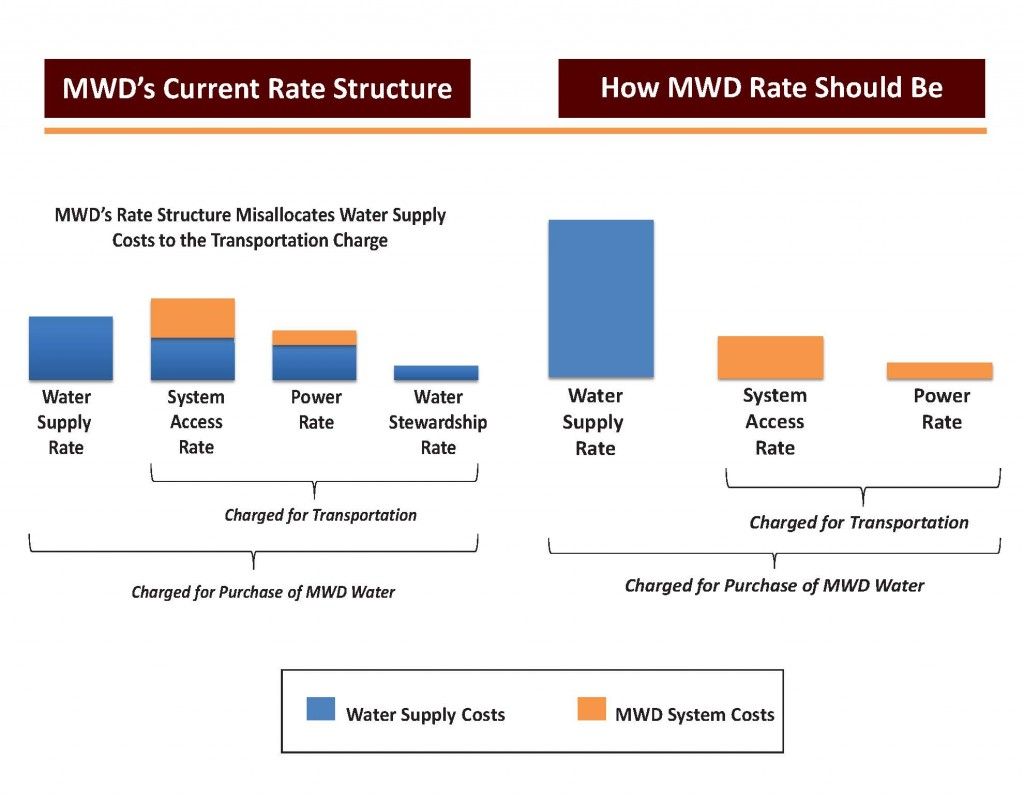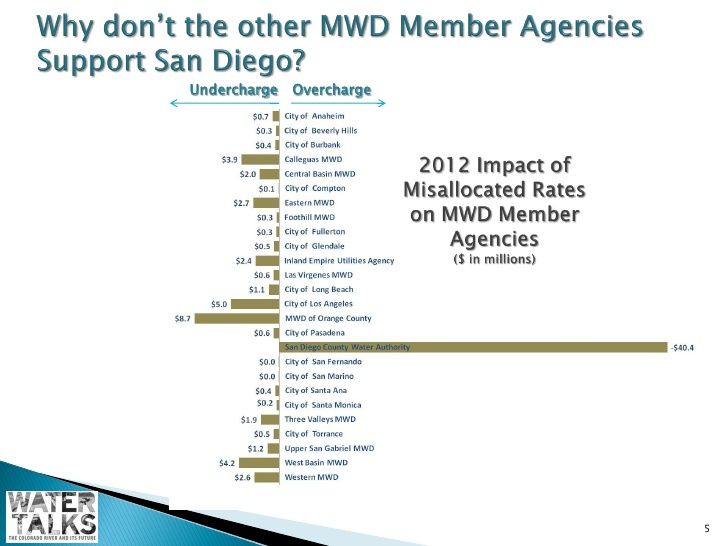San Diego Wheels, Deals and Sues for Water
May 7, 2012
By Wayne Lusvardi
San Diego’s recent transfer of excess agricultural water from Imperial County has been the only major addition to urban water sources for Southern California for decades. The transfer is the largest agriculture-to-urban water transfer in U.S. history. And it originated in the lining of irrigation canals by the San Diego County Water Authority. This resulted in bringing enough previously wasted farm water to serve 1.2 million people in the San Diego area.
But a partially market-driven water system, as recently proposed by economist Art Laffer, might offer a better solution to California’s dysfunctional water system.
Under- or Over-Charging?
Is the rate charged for San Diego County to convey excess agricultural water through the Colorado River Aqueduct to San Diego a fair deal? Sociologist Steven Erie of the University of San Diego thinks so. He even goes further and says the Metropolitan Water District of Southern California has been subsidizing San Diego water rates for decades.
As evidence for his claim that MWD is not overcharging, but subsidizing, water rates for San Diego, professor Erie cites a recent study he co-authored with Greg Freeman for the Los Angeles Economic Development Corporation. The study is titled, “The Cost of Water in San Diego: The Imperial Irrigation District Water Transfer and San Diego County Water Authority Water Rates.” The study was commissioned by MWD.
San Diego Waterboards Prof. Erie
But first: What do water purchase rates have to do with “water wheeling” rates?
Water wheeling is a utility industry term. Wheeling is the conveying of water through the unused capacity in a pipeline or aqueduct by another water provider. Water wheeling is provided for under Section 1810 of the California Water Code.
It isn’t the price of water that is at issue, but the cost to transport it in unused space or excess capacity called “freeboard” in a pipeline or aqueduct. Freeboard is defined as the distance between the normal water level and the top of a pipe or the top of the canal bank of an aqueduct.
As the San Diego County Water Authority states on its website “MWD Facts”:
“1. The price San Diego pays the Imperial Irrigation District for its transfer supplies has nothing to do with whether or not MWD’s transportation rates are legal.
“2. San Diego’s court challenge is over the price that the Metropolitan Water District of Southern California charges San Diego to transport water purchased from Imperial County. San Diego is not suing Imperial County over the price it pays for water supplies.
“3. All of Southern California has benefitted from this additional supply of water, not just San Diego.”
So Erie’s argument that San Diego’s water rates have been subsidized for decades is irrelevant to the issue of the proper water transport rate in the ongoing legal dispute between San Diego County and MWD. Any attempt to introduce such data would likely be ruled as irrelevant in the San Diego versus MWD water rate overcharging court case.
San Diego paid $491 per acre-foot for excess farm water from Imperial County. If this was a bad bargain, why does the city of San Francisco consider $700 per acre-foot for its purchase of water from the Modesto Irrigation District a bargain price? According to San Francisco officials, the answer is: because a $700 per acre-foot water transfer beats the cost of alternatives such as recycling, conservation, groundwater and desalinization.
And if California water law forbids charging more than the recovery of a proportionate share of “full system costs,” how is it that the Modesto Irrigation District brags that it upgraded its facilities and will only use “some” of the income to catch water before it flows into nearby rivers for diversion to San Francisco?
San Diego’s View of Water Dispute
What is at really in dispute is the water rate that MWD can lawfully charge San Diego to wheel water through the Colorado River and San Diego Pipeline systems. MWD is required by law to charge rates that reflect only the actual, reasonable and proportionate costs of serving each class of its customers (urban or agricultural).
Erie claims, however, that San Diego paid too much for agricultural water and is now trying to fend off a water ratepayer revolt. The initial water price for San Diego’s acquisition of surplus farm water is $491 per acre-foot of water. An acre-foot of water is an acre of land flooded with one foot high of water. An acre-foot is enough water to supply two urban families for one year or irrigate about one-third of an acre of cropland for a year.
San Diego County’s lawsuit claims MWD is overcharging in the three water sub-rates that make up its water transportation charge. According to MWD’s Water Rates posted online, the three rates that make up the transportation charge are as follows:
MWD Water Transport Rate
|
2012 |
2013 |
Percent Change |
|
| System Access Rate |
$217 |
$223 |
+2.7% |
| Power Rate |
$136 |
$189 |
+38.9% |
| Water Stewardship Rate |
$43 |
$41 |
-4.6% |
| Total Transport Rate |
$396 |
$453 |
+14.4% |
| Source: http://www.mwdh2o.com/mwdh2o/pages/finance/finance_03.html | |||
.
Once again, the above total transport rate of $396 per acre-foot of water for 2012 cannot be compared with San Diego’s excess farm water rate of $491 per acre-foot. That would be like comparing the wholesale price of an un-harvested apple on a tree with the retail price of an apple for sale in a store. That is not an “apples to apples” price comparison.
Is MWD Double Dipping?
San Diego claims that MWD is overcharging for its water transport rate. This is because the sub-rates that comprise the transport rate allegedly overlap, leading to possible double charging. See the graph below.
San Diego is geographically “at the end of the pipeline” of MWD’s system. It would thus pay the greatest transport costs compared to other water agencies that are members of MWD. If San Diego’s contention were proven in a court of law, MWD’s water transport rate would be a subsidy to water ratepayers in Los Angeles and an overcharge on San Diego ratepayers. This is the opposite of professor Erie’s unsupported contention that MWD is subsidizing San Diego’s water rates.
Water Wheeling Reduces Water System Fixed Costs
Arguably, San Diego’s conveyance of an additional 200,000 acre feet of water acquired from farmers through the Colorado River Aqueduct would hypothetically lower the aqueduct’s fixed operational costs by 5 percent of the 4.4 million acre-feet of water it conveys annually. Power costs would have to be deducted for pumping the water; 200,000 acre-feet is enough water to serve 1.2 million people.
The transfer of water from Imperial County farmers to urban San Diego County also frees up an equal 200,000 acre-feet of water in MWD’s system for use by its other member agencies in Los Angeles, Orange, Riverside, San Bernardino and Ventura counties.
MWD Prevailed In Prior Lawsuit
San Diego County initially prevailed in court in prior water wheeling rate disputes with MWD. However, the Second District Court of Appeal overturned that decision holding MWD: (1) was entitled to recover its system-wide costs not just the incremental cost caused by the wheeling transaction; (2) may base its charges on a one price “postage stamp” basis instead of charging only for the part of MWD’s system; and (3) is not prohibited from setting a fixed wheeling rate for all wheeling transactions.
In a socialized water system, a regional water wholesaler such as MWD is apparently entitled to charge for wheeling another water agency’s water based on a pro rata share of total system costs. San Diego’s contention that it should only be charged for the additional cost to the affected part of MWD’s system was denied. San Diego’s wheeling of 200,000 acre feet of water per year through MWD’s total system would reflect about 3.1 percent of MWD’s average annual 6.4 million acre-feet of imported water.
In a market system, both costs and benefits could be considered, rather than only costs. San Diego’s 200,000 acre-feet of wheeled water per year would reflect $79.2 million of additional annual revenue to offset fixed costs of operating the Colorado River Aqueduct (200,000 x $396/Acre-Foot). This is perhaps another fatal flaw in a socialized water system.
However, that MWD can charge full system costs for water wheeling is apparent not the issue in the current court case. San Diego asserts that the formula MWD uses for its water transportation rate overcharges by doubling up components of the fee.
The Appeals Court ratified MWD’s policy of charging full system cost over its six county service area rather than only the costs for the Colorado River-San Diego Pipeline system. This appears to run against past recommendations of the Committee on Water Rates of the American Water Works Association.
In the past, the American Water Works Association has recommended that the appropriate rate set between two pure government entities for allocating “joint capacity costs” should not exceed the demonstrable additional costs involved in providing such a service. An example would be the rate set for a fire protection service to wheel water through a municipal water line. According to the AWWA, “[T]he costs allocated to fire protection should not exceed the demonstrable additional costs involved in rendering such service” (cited in Paul J. Garfield and Wallace F. Lovejoy, Public Utility Economics, 1964: p. 233).
By setting a standard of having to pay “full system costs,” the courts have not only deterred a water market, but water transfers between pure government entities that could alleviate California’s water crisis. Again, this reflects more dysfunction in California’s water system.
Are There Alternatives to Paying Wheeling Fees?
Neither the local nor the appeals court indicated, however, if San Diego was prohibited from using eminent domain to acquire a specific co-location wheeling easement or leasehold in the freeboard excess capacity within specified aqueducts and pipelines of MWD. If so, San Diego might be able to pay “Fair Market Value” for wheeling water through the unused portion of a pipeline instead of a monopoly unit price of the total MWD system cost.
In 1999 to 2001, a market price for co-location easements supplanted eminent domain just compensation for telecom communications corridors for regulated public utilities. San Diego is exploring building its own pipeline to Imperial County. Perhaps San Diego could co-locate its own pipe in the rights of way for the Colorado River Aqueduct.
Various aquifers around the Salton Sea may flow into each other. But suppose water was put in upstream in exchange for withdrawal rights at the other end of the slope closer to San Diego to cut pipeline and right of way acquisition costs?
Socialized Water System Has No Incentive for Conservation
Economist Art Laffer points out that California could solve nearly all of its many raging water wars if it shifted to a modified market water system, albeit with some set asides for environmental water. Laffer cites a study by Dorothy Robyn of California’s water pricing system. Robyn’s study indicates that a reduction in private water rights “removed the incentive for conservation” because in a socialized system “there is little reason to avoid waste.”
Thus, a socialized water system ends up with water agencies like San Diego’s having to get a court order to compel farmers to conserve water. San Diego County filed a lawsuit against Imperial County and Coachella Valley to allow San Diego to line irrigation canals with concrete to avoid leakage. The canal lining was at San Diego’s expense.
In a market system, farmers would have an incentive to conserve their excess water and re-sell it for a profit. And according to Lawrence Livermore Labs, the Salton Sea might have enough water in rechargeable groundwater basins to supplant a large share of the Colorado River water now shipped to San Diego.
Water Runs Downhill Toward Politics
It once was probably true that in California that “water ran uphill toward money.” But the system California now has allows water to go to the most politically connected. Perhaps farmers need a separate water system such as the Federal Central Valley Project. But environmentalists oppose farmers reselling water for a profit, even though such a system would result in more water conservation.
This is why San Diego alleges that a cabal of water agencies in the Metropolitan Water District is overcharging for excess water wheeled through its regional plumbing system. In a socialized system, there is an incentive to game the system for gain.
San Diego doesn’t want to pay for all the contrived jobs programs of MWD. MWD’s origins were as a 1930’s Works Progress Administration style “stimulus” jobs program. MWD’s policy has been to launch large public works projects during economic recessions to stimulate the regional economy.
Below is a chart of what San Diego County contends is the amount of subsidy it pays to MWD’s other water agencies and the amount of overcharge in the water wheeling rate it must pay.
Why California Water System Is Dysfunctional
California is dysfunctional not because of too few taxes, or lack of supermajority rule of the Legislature or the courts. Its water system is not dysfunctional because of lack of voter approval of yet another water bond.
It is dysfunctional partly because it has replaced private property rights and markets with a socialized water system. This is partly why California only has about a half-year of water storage in both the State and federal water systems, while the Colorado River system has four to 10 years of water storage. And it is why California has squandered five “waterless” water bonds totaling $18.7 billion on mostly open space land acquisitions with no storage reservoirs to show for it.
And what California has done to water rights has also flooded the entire governmental regulation of the economy. Such a system encourages the formation of political coalitions of academics, technical consultants, and activists who all become parasites off the dysfunctional water system. The more such special interests advocate, the less functional the system becomes.
The number of people now dependent for their livelihood on such a parasitic system is so large that is nearly impossible to reverse it. And it is sinking the economy and with it government budgets at every level.
Related Articles
Enviros battle over merits of rooftop solar vs. desert solar
Things aren’t working out well for renewable energy advocates who hoped cheaper rooftop solar energy would replace large solar power
California seeks fourth federal disaster declaration
Still reeling from a wild weather season, California chalked up a fourth request for federal disaster aid, as Gov.
Ground broken on troubled high-speed rail project
Yesterday in Fresno the California High-Speed Rail Authority officially conducted the groundbreaking ceremony for its bullet-train project – but







